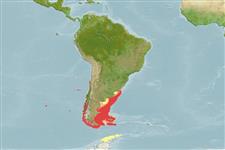Common names from other countries
Environment: milieu / climate zone / depth range / distribution range
Ekologi
; kisaran kedalaman 1 - 270 m (Ref. 87801), usually 70 - 120 m (Ref. 114844). Subtropical, preferred 8°C (Ref. 107945); 26°S - 65°S, 110°W - 53°W
Southeast Pacific, Southwest Atlantic and Antarctic: Magellanic biogeographic province. In the Pacific from Puerto Montt to Strait of Magellan and Cape Horn (56°S) to the Atlantic northwards to Rio de la Plata estuary (35°S). Also from Palmer Archipelago, Antarctica and Easter Island. Introduced in the Mediterranean. Subtropical to polar.
Length at first maturity / Size / Weight / umur
Maturity: Lm ? range ? - ? cm Max length : 7.8 cm SHL jantan/; (Ref. 83435)
The Patagonian scallop fishery of this species has been certified by the Marine Stewardship Council (http://www.msc.org/) as well-managed and sustainable (http://www.msc.org/html/content_1294.htm). This is an epifaunal species found at depths of 1 to 270 meters. Adults live on the bottom supported by their right valve while juveniles appear as epibionts of algae and other invertebrates. Single species found in shallow waters and forms large banks in deeper waters. Larvae are free-living (Ref. 87801). It is found in forests of Macrocystis pyrifera (Ref. 92889).
Life cycle and mating behavior
Kematangan | Reproduksi, perkembang biakan | Pemijahan | telur-telur | Fecundity | Larva
Members of the class Bivalvia are mostly gonochoric, some are protandric hermaphrodites. Life cycle: Embryos develop into free-swimming trocophore larvae, succeeded by the bivalve veliger, resembling a miniature clam.
rujukan utama
Acuan | Koordinator | mitra
Rosenberg, G. 2009. (Ref. 83435)
Status IUCN Red List (Ref. 130435)
status CITES (Ref. 108899)
Not Evaluated
Not Evaluated
ancaman kepada manusia
Harmless
penggunaan manusia
Perikanan: komersial
FAO - Perikanan: landings | FishSource | Sea Around Us
Alat, peralatan
Sumber internet
Estimates based on models
Daya lenting
Tinggi, Waktu penggandaan populasi minimum kurang dari 15 bulan (K=0.19-0.62).
Prior r = 0.57, 95% CL = 0.37 - 0.85, Based on 1 data-limited stock assessment.
